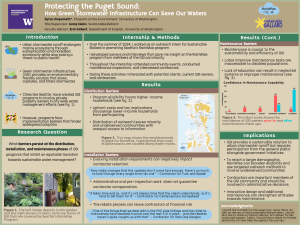Protecting the Puget Sound: How Green Stormwater Infrastructure Can Save our Waters
Urban stormwater runoff is contaminated by pollutants such as oil, fertilizers, excrement, and bacteria, posing a significant threat to marine ecosystems and public health. These pollutants are toxic to marine life in their own right but also cause detrimental effects to the larger ecosystem through eutrophication and the bioaccumulation of toxins within fish. Public health is at risk as the bacteria carried by stormwater runoff contaminates sources of drinking water and areas used for recreation, increasing exposure to water-borne illnesses. As the issue of stormwater management is exacerbated by climate change and aging infrastructure, green stormwater infrastructure (GSI) offers a sustainable solution that treats stormwater before it enters sewage systems and waterways. However, persisting barriers to GSI adoption have prevented large scale public participation. This study investigates challenges within King County’s RainWise program, focusing on structural inequities and operational obstacles across three phases: distribution, installation, and maintenance. Through community outreach, maintenance assessments, and contractor interviews the research identifies systemic issues faced by distinct populations that interact with the program. Distribution barriers reveal socioeconomic inequities, as eligibility criteria and upfront costs disproportionately favor higher-income households. Installation challenges include evolving program requirements, cumbersome paperwork, and rebate disputes that strain contractor participation. Maintenance struggles stem from inadequate owner education and physically demanding tasks. The findings underscore the necessity of structural reforms to align urban stormwater strategies with principles of environmental justice and participatory governance. By centering stakeholder feedback, this study advocates for adaptive GSI programs to enhance climate resilience and ensure equitable access.
